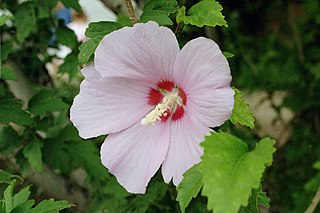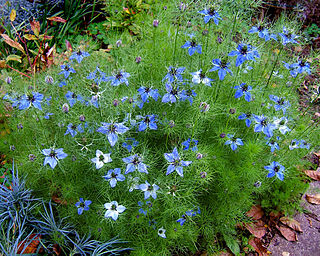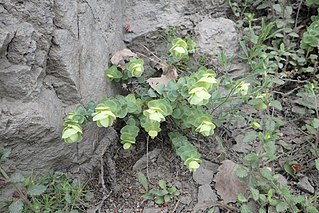
Salvia rosmarinus, commonly known as rosemary, is a shrub with fragrant, evergreen, needle-like leaves and white, pink, purple, or blue flowers, native to the Mediterranean region. Until 2017, it was known by the scientific name Rosmarinus officinalis, now a synonym.

Spearmint, a species of mint (mentha) scientifically classified as Mentha spicata (,) also known as garden mint, common mint, lamb mint and mackerel mint, is native to Europe and southern temperate Asia, extending from Ireland in the west to southern China in the east. It is naturalized in many other temperate parts of the world, including northern and southern Africa, North America, and South America. It is used as a flavouring in food and herbal teas. The aromatic oil, called oil of spearmint, is also used as a flavoring and sometimes as a scent.

Geranium maderense, known as giant herb-Robert or the Madeira cranesbill, is a species of flowering plant in the family Geraniaceae, native to the island of Madeira. It is sometimes confused with another Madeira endemic, Geranium palmatum.

Pelargonium is a genus of flowering plants that includes about 280 species of perennials, succulents, and shrubs, commonly called geraniums, pelargoniums, or storksbills. Geranium is also the botanical name and common name of a separate genus of related plants, also known as cranesbills. Both genera belong to the family Geraniaceae. Carl Linnaeus originally included all the species in one genus, Geranium, and they were later separated into two genera by Charles Louis L'Héritier de Brutelle in 1789.

Hibiscus syriacus is a species of flowering plant in the mallow family, Malvaceae. It is native to south-central and southeast China, but widely introduced elsewhere, including much of Asia, both in the east and the west. It was given the epithet syriacus because it had been collected from gardens in Syria. Common names include the rose of Sharon,, Syrian ketmia, shrub althea, and rose mallow. It is the national flower of South Korea and is mentioned in the South Korean national anthem.

Nigella damascena, love-in-a-mist, or devil in the bush, is an annual garden flowering plant, belonging to the buttercup family Ranunculaceae. It is native to southern Europe, north Africa and southwest Asia, where it is found on neglected, damp patches of land.

Myrrhis odorata, with common names cicely, sweet cicely, myrrh, garden myrrh, and sweet chervil, is a herbaceous perennial plant belonging to the celery family Apiaceae. It is the only species in the genus Myrrhis.

Lavandula angustifolia, formerly L. officinalis, is a flowering plant in the family Lamiaceae, native to the Mediterranean. Its common names include lavender, true lavender and English lavender ; also garden lavender, common lavender and narrow-leaved lavender.

Cleome houtteana, commonly known as spider flower, spider plant, pink queen, or grandfather's whiskers, is a species of flowering plant in the genus Cleome of the family Cleomaceae, native to southern South America in Argentina, Paraguay, Uruguay, and southeast Brazil. It has also been introduced to South Asia, including the Haor area of Bangladesh and India.

Symphyotrichum ericoides, known as white heath aster, frost aster, or heath aster, is a species of flowering plant in the family Asteraceae native to much of central and eastern North America. It has been introduced to parts of Europe and western Asia.

Geum quellyon, commonly called scarlet avens, Chilean avens, Double Bloody Mary, or Grecian rose, is a perennial herb in the family Rosaceae. It is native to the central and southern regions of Chile. G. quellyon has been introduced to other countries including Belgium, Bolivia, and the United Kingdom, where it was first planted in 1826.

Symphyotrichum lateriflorum is a species of flowering plant in the aster family (Asteraceae). Commonly known as calico aster, starved aster, and white woodland aster, it is native to eastern and central North America. It is a perennial and herbaceous plant that may reach heights up to 120 centimeters and widths up to 30 centimeters.

Clematis montana, the mountain clematis, also Himalayan clematis or anemone clematis, is a flowering plant in the buttercup family Ranunculaceae. A vigorous deciduous climber, in late spring it is covered with a mass of small blooms for a period of about four weeks. The odorous flowers are white or pink, four-petalled, with prominent yellow anthers. It is native to mountain areas of Asia from Afghanistan to Taiwan.

Geranium macrorrhizum is a species of hardy flowering herbaceous perennial plant in the genus Geranium, family Geraniaceae. It is native to the South east Alps and the Balkans. Its common names include bigroot geranium, Bulgarian geranium, and rock crane's-bill.

Salvia is the largest genus of plants in the sage family Lamiaceae, with nearly 1000 species of shrubs, herbaceous perennials, and annuals. Within the Lamiaceae, Salvia is part of the tribe Mentheae within the subfamily Nepetoideae. One of several genera commonly referred to as sage, it includes two widely used herbs, Salvia officinalis and Salvia rosmarinus.

Tulbaghia violacea, commonly known as society garlic, pink agapanthus, wild garlic, sweet garlic, spring bulbs, or spring flowers, is a species of flowering plant in the family Amaryllidaceae, indigenous to southern Africa, and reportedly naturalized in Tanzania and Mexico.

Origanum laevigatum is a species of flowering plant in the family Lamiaceae, native to Cyprus, Syria, and Turkey. Growing to 50–60 cm (20–24 in) tall by 45 cm (18 in) wide, it is a woody-based perennial, with strongly aromatic leaves, and loose clusters of pink funnel-shaped flowers with persistent purple bracts, throughout the summer.

Origanum rotundifolium, the round-leaved oregano, is a species of flowering plant in the family Lamiaceae, native to Turkey, Armenia and Georgia. It is a small woody-based perennial or subshrub growing to 10–30 cm (4–12 in) tall by 30 cm (12 in) wide, with strongly aromatic leaves, and loose clusters of pink flowers with hop-like pale green bracts, throughout the summer.

Thymus pulegioides, common names broad-leaved thyme or lemon thyme, is a species of flowering plant in the family Lamiaceae, native to Europe. Growing to 5–25 cm (2–10 in) tall by 25 cm (10 in) wide, it is a small spreading subshrub with strongly aromatic leaves, and lilac pink flowers in early summer. The specific epithet pulegioides highlights its similarity to another species within Lamiaceae, Mentha pulegium (pennyroyal).

Rosa stylosa, the short-styled field rose, is a species of flowering plant in the family Rosaceae, native to western and southern Europe, and northwestern Africa. It has gone extinct in Hungary. It is not readily available from commercial suppliers.




















